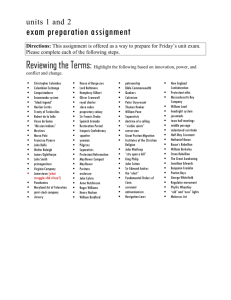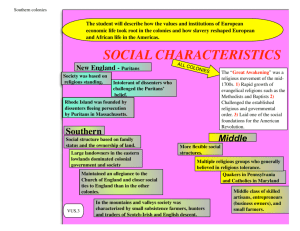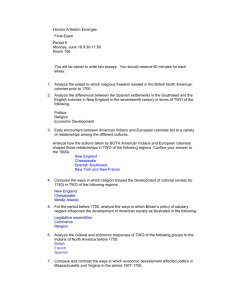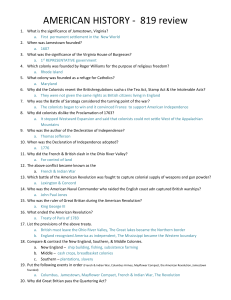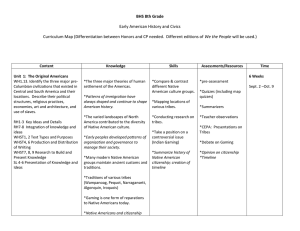5th Grade Social Studies - Archdiocese of Kansas City in Kansas
advertisement
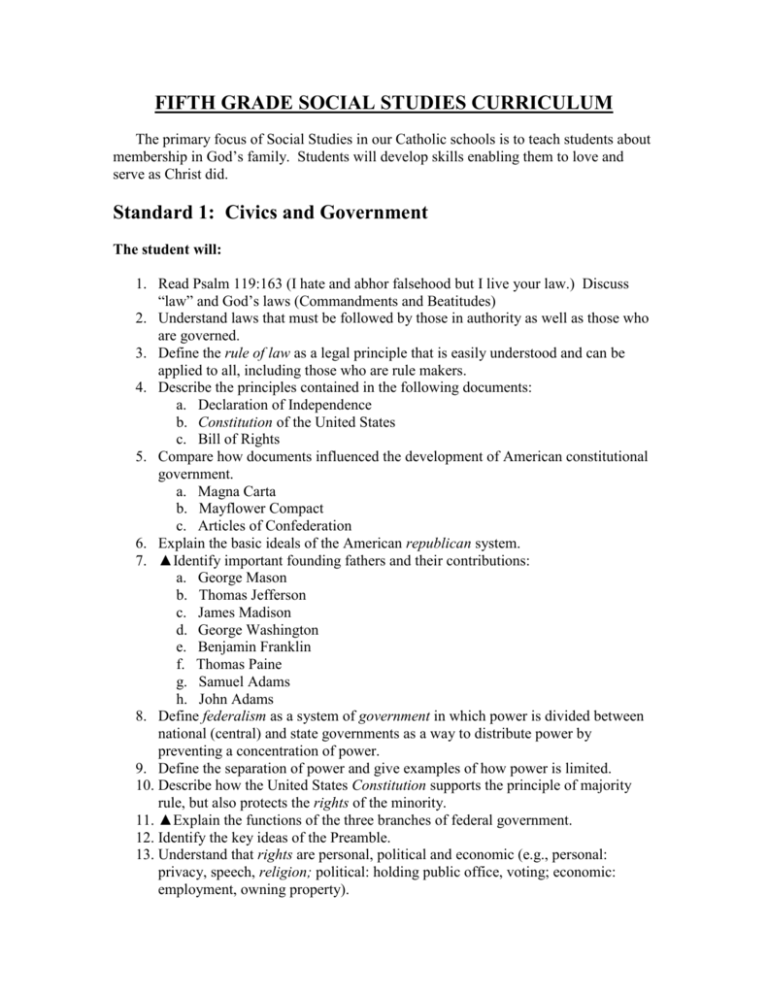
FIFTH GRADE SOCIAL STUDIES CURRICULUM The primary focus of Social Studies in our Catholic schools is to teach students about membership in God’s family. Students will develop skills enabling them to love and serve as Christ did. Standard 1: Civics and Government The student will: 1. Read Psalm 119:163 (I hate and abhor falsehood but I live your law.) Discuss “law” and God’s laws (Commandments and Beatitudes) 2. Understand laws that must be followed by those in authority as well as those who are governed. 3. Define the rule of law as a legal principle that is easily understood and can be applied to all, including those who are rule makers. 4. Describe the principles contained in the following documents: a. Declaration of Independence b. Constitution of the United States c. Bill of Rights 5. Compare how documents influenced the development of American constitutional government. a. Magna Carta b. Mayflower Compact c. Articles of Confederation 6. Explain the basic ideals of the American republican system. 7. ▲Identify important founding fathers and their contributions: a. George Mason b. Thomas Jefferson c. James Madison d. George Washington e. Benjamin Franklin f. Thomas Paine g. Samuel Adams h. John Adams 8. Define federalism as a system of government in which power is divided between national (central) and state governments as a way to distribute power by preventing a concentration of power. 9. Define the separation of power and give examples of how power is limited. 10. Describe how the United States Constitution supports the principle of majority rule, but also protects the rights of the minority. 11. ▲Explain the functions of the three branches of federal government. 12. Identify the key ideas of the Preamble. 13. Understand that rights are personal, political and economic (e.g., personal: privacy, speech, religion; political: holding public office, voting; economic: employment, owning property). 14. Understand that privileges require qualifications. 15. Recognize that rights require responsibilities of citizenship. 16. Demonstrate proper flag etiquette. 17. Examine steps necessary to become an informed voter. Standard 2: Economics The student will: 1. Understand the importance of stewardship in meeting the needs of the others in the Parish community. 2. Explain how scarcity of resources requires making choices about goods and services. 3. Determine how unlimited wants and limited resources lead to choices that involve opportunity costs. 4. Describe how specialization results in increased productivity. 5. Give examples of economic interdependence at the local, state, regional, or national level. 6. Define supply and demand. 7. ▲Identify factors that change supply or demand for a product (e.g., supply: technology changes; demand: invention of new and substitute goods; supply or demand: climate and weather). 8. Describe how changes in supply and demand affect prices of specific products. 9. Understand that banks are institutions where people save money and earn interest and where people borrow money and pay interest. 10. Give examples of how positive and negative incentives affect people’s behavior (e.g., laws: Stamp Act, Sugar Act; profit; product price; indentured servant). 11. Recognize barriers to trade among people across nations (quotas, tariffs, boycotts, geography). 12. Describe revenue sources for different levels of government. 13. ▲Determine the costs and benefits of a spending, saving, or borrowing decision. 14. Recognize that supply of and demand for workers in careers affect income. Standard 3: Geography The student will: 1. Explain and use map titles, symbols, cardinal directions, and intermediate directions, legends, latitude and longitude. 2. Locate major physical and political features of Earth from memory: ▲Boston ▲North America ▲Philadelphia ▲Atlantic Ocean ▲England ▲Pacific Ocean ▲France Caribbean Sea ▲Italy Yucatan Peninsula ▲Spain Germany Aleutian Islands Netherlands Bering Strait Norway Chesapeake Bay Ohio River Hudson Bay Portugal Mexico City Quebec City Montreal St. Lawrence River 3. Identify and compare the major physical characteristics of the New England Colonies, Middle Colonies, and Southern Colonies and French and Spanish territories. 4. Identify and compare the human characteristics of the New England Colonies, Middle Colonies, and Southern Colonies and French and Spanish territories (e.g., national origins, religion, customs, government, agriculture, industry, and architecture). 5. Identify renewable and nonrenewable resources and their uses. 6. Explain reasons for variation in population distribution. 7. Identify the push/pull factors of human migration (e.g., push: war, famine, lack of economic opportunity; pull: religious freedom, economic opportunity, joining family or friends). 8. Describe the effects of human migration on place and population. 9. Describe factors that influence and change the location and distribution of economic activities. 10. Understand that forces of conflict and cooperation divide or unite people (e.g., religious intolerance, land disputes). 11. Examine varying viewpoints regarding resource use (American Indian vs. European settler, past vs. present). 12. Identify the relationship between the acquisition and use of natural resources and advances in technology using historical and contemporary examples (compass for navigation, water power, steel plow). Standard 4: History The student will: 1. Research the history of religious orders in the Archdiocese. 2. ▲Explain how various American Indians adapted to their environment in relationship to shelter and food. a. Plains b. Woodland c. Northwest Coast d. Southeast e. Pueblo 3. Show how traditional arts and customs of various American Indians are impacted by the environment. (see above) 4. ▲Compare the motives and technology that encouraged European exploration of the Americas. 5. Examine the interaction between European explorers and American Indians. 6. Explain why early settlements succeeded or failed (e.g., Pilgrims, Puritans, St. Augustine, Quebec). 7. Map the patterns of colonial settlement. 8. ▲Describe political and economic structures in the New England, Middle, and Southern Colonies. 9. Compare and contrast the impact of European settlement from an American Indian and European point of view. 10. Analyze the causes and impact of forced servitude in North America (indentured servant, Middle Passage, and slave life). 11. Explain the causes and effects of the French and Indian War on the American Revolutionary period. 12. Explain the impact of religious freedom as colonies were settled by various Christian groups (Catholics in Maryland, Quakers in Pennsylvania, Puritans in Massachusetts). 13. ▲Describe the causes of the American Revolution (e.g., Proclamation of 1763, Intolerable Acts, Stamp Act, taxation without representation). 14. Explain the significance of important groups in the American Revolution a. Loyalists b. Patriots c. Sons of Liberty 15. Examine the significance of important turning points in the American Revolution. a. Boston Massacre b. Continental Congress c. Boston Tea Party d. Lexington and Concord e. Saratoga f. Valley Forge g. Yorktown 16. Discuss the international support for the American Revolution. 17. Discuss the strengths and weaknesses of the Articles of Confederation. 18. ▲Describe how the Constitutional Convention led to the creation of the United States Constitution. a. Great Compromise b. Three-Fifths Compromise 19. Recognize the importance of the presidency as it was defined by George Washington. 20. Explain United States land policy and its impact on American Indians (e.g., sale of western lands, Land Ordinance of 1785, the Northwest Ordinance of 1787). 21. ▲Use historical timelines to trace the cause and effect relationships between events in different places during the same time period (Colonial America and England). 22. Examine multiple primary sources to understand point of view of an historical figure. 23. Locate information using a variety of sources to support a thesis statement. 24. Use information including primary sources to debate a problem or an historical issue. 25. Observe and draw conclusions. 26. Use research skills to interpret an historical person or event in history and note the sources of information. ▲ Assessed Indicator FIFTH GRADE VOCABULARY Articles of Confederation Benefit Borrowing Constitution Consumer Copyright Cost Culture Demand Diffusion Distribution Economic interdependence Economy Federalism Feudalism Goods Government Incentives Income Interest Latitude Legend Location Longitude Magna Carta Mayflower Compact Migration Natural resource Opportunity cost Patent Places Political features Population distribution Price Primary source Privileges Production Productivity Profit Push-pull factors Region Religion Renewable resource Resource Responsibility Revenue Rights Rule of law Scarcity Secondary source Services Specialization Spending Supply Technology Trade Wants




